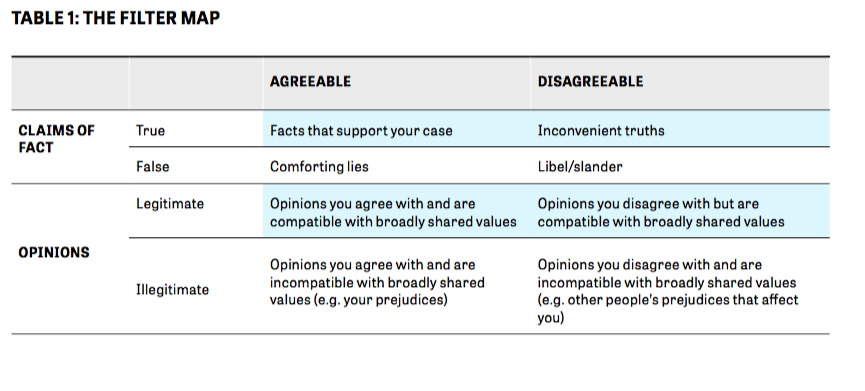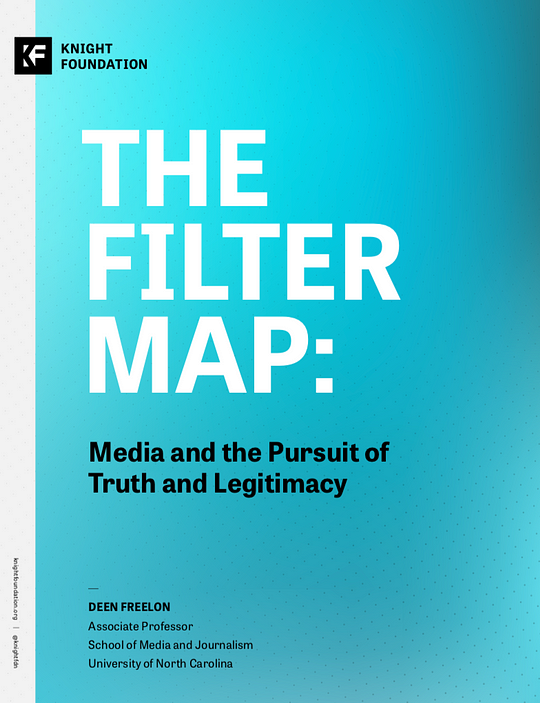By Deen Freelon, for Trust, Media and Democracy
Why we need to think about truth and legitimacy when consuming news, & the three-dimensional filter map that helps
Americans today are often scolded for living inside of social media filter bubbles, avoiding news stories and opinions that are challenging or don’t fit into our world views. It’s true that, as with food, what appeals to us most immediately is not always the healthiest or most useful — for example, soft news and infotainment are sometimes blamed for emphasizing the most salacious and least consequential aspects of public affairs. Then there is outright factually untrue content designed to look authentic–what is sometimes called “fake news”–which usually targets those who agree with the false message.
But as a social scientist, I need to raise a slight empirical quibble with the notion that most people only consume content they agree with. Careful research has shown this to be incorrect, instead finding that while people prefer messages that support their opinions, they do not systematically avoid disagreeable messages.
Furthermore, I object more fundamentally to the notion that all mass affirmation is always bad, and its corollary, that unwanted or unplanned encounters are always good. In true academic fashion, I will argue that it depends: each can sometimes be good and sometimes bad. This implies that we should not program our filters to use agreeableness as a primary decision rule, nor should we use it to determine whether to take messages seriously.
I have an alternative suggestion for how to think about the information we consume that goes a step beyond the idea of a generically diverse media diet. It involves not one conceptual dimension but three, which combine to create a filter map onto which we can project most of the messages we will encounter. These three dimensions are:
- Agreeableness. This is the degree to which information fits into our preexisting opinions.
- Truth value. This is simply whether a given message is true or false.
- Legitimacy. This is the most difficult to define of all. The term is borrowed from Daniel Hallin’s 1986 book The Uncensored War, in which he coins the phrase “sphere of legitimate controversy” to cover all opinions considered to be acceptable within a given society. In the United States, as in advanced democracies more generally, this usually reduces to an opinion’s adherence to widely accepted ethical norms like freedom, equality, fairness and human rights. While there is considerable debate around what kinds of opinions comport with such principles, it can be safely said that crimes like racial discrimination, torture and arbitrary detention definitively violate them.
Legitimacy is solely a property of opinions, while truth value applies only to facts. Agreeableness cuts across both facts and opinions.
The filter map that emerges from the intersection of these three dimensions offers a simple guide to the kinds of information one should strive to consume and avoid (see image below). Ideally, our media filters would optimize for truth and legitimacy, ensuring that both agreeable and disagreeable content and sources are included (the map’s four blue cells).
By the same token, false and illegitimate messages would be excluded, again regardless of agreeableness (the four white cells). The conceptual leap I make here is from considering disagreeableness as a virtue in itself, to distinguishing between more and less desirable types of disagreeable content. There are many claims and opinions we should rightly dismiss out of hand, but there are others we should entertain despite disagreeing with them.

Developing this framework has been an engaging intellectual exercise, but if it can’t be applied selectively in practice, it will have been strictly an academic one. But several existing initiatives point the way toward what I’ve proposed. Most social media platforms are built to maximize the agreeableness of the content the user sees, so many of their features would need to be discarded at the outset. We are looking to build a system that delivers true and legitimate content from across our personal agreement spectrum.
In some ways, the desired result resembles the content of a national daily newspaper or newscast. But our ideal system would improve upon the well-known legacy news outlets in several ways. First, it would present a much wider range of content than what has traditionally been considered “newsworthy” by drawing on the value judgments of more than just news editors about what is worth sharing. This is extremely important given the longstanding problems with institutional inclusion in journalism–whenever news judgments come from a largely homogeneous group, certain topics will inevitably be underrepresented.
Relatedly, some of the most deeply ingrained journalistic practices require the inclusion of content that lies outside the filter map’s blue cells. When reporters insist on presenting views from “both sides” of certain issues, falsehoods are often presented as equivalent to truth. This used to be common in discussions of climate change, where climate deniers were presented on equal footing with the scientific consensus, although that has changed for the better recently.
The desire to appear objective has also left news outlets poorly equipped to handle situations where one side lies disproportionately more often than the other. A filtering system that does not claim objectivity would not have this problem: all messages that meet our blue criteria would be admitted. Instead, it would seek a different kind of balance–that between agreeable and disagreeable blue content.
Above all, we should remember that everything we accept as true or legitimate today is subject to change down the road. Therefore, it will sometimes be necessary to repudiate previously accepted messages that turn out to be false or illegitimate. It is this habit, more than any technical solution, that will bring us closer to the truth and rectitude most of us claim to want.
This piece is adapted from “The Filter Map: Media and the Pursuit of Media and Legitimacy,” part of a white paper series on media and democracy commissioned by the John S. and James L. Knight Foundation. Read the complete paper and learn more about how the filter map can help guide information consumption.






